Impact of Big Data on Transport for London (TFL)

Date: February 14, 2024
Introduction
The transportation sector is undergoing a significant transformation fueled by the ever-growing power of big data. As depicted in Figure 1, interest in big data has surged in recent years, reflecting its vast potential for improving efficiency, safety, and passenger experience. Transport for London (TfL), responsible for managing London’s complex network of buses, trains, and cycling infrastructure, has emerged as a frontrunner in adopting big data solutions.
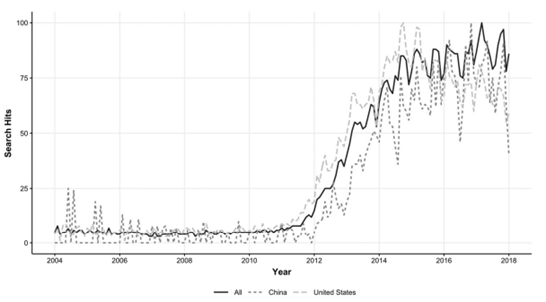
Figure 1: Google Trends showing the popularity of search team big data (Welch & Widita, 2019).
This report examines TfL’s innovative use of big data while acknowledging areas for further development. TfL’s approach aligns with the global trend of extensive data adoption in transportation, which began around 2013 (refer to Figure: 1). This analysis explores how TfL leverages big data to optimise resource allocation, improve schedules and routes, and enhance passenger communication, ultimately leading to a more efficient and user-friendly transportation network. The report also discusses challenges related to data integration, privacy concerns, and opportunities for further improvement through advanced technologies like artificial intelligence and machine learning.
Project Landscape
Transport for London (TfL) emerges as a frontrunner in adopting big data solutions to manage its sprawling network (over 9,300 buses, London Underground with 272 stations serving 5 million daily passengers) (Transport for London,2024). One of TfL’s early successes was the “Trackernet” system, launched in 2010 using Microsoft Azure (Microsoft Azure, 2010). This initiative provided real-time data like location, timetables, and traffic information to the public and developers, fostering app development that benefitted passengers. TfL later expanded this system with a “Unified API” that incorporated Oyster card data, GPS coordinates, CCTV footage, and sensor readings, offering valuable insights for passenger experience optimisation (Transport for London,2024).
Another noteworthy solution is the “ODX” system, which tackles the challenge of tracking bus journey completion due to the single tap-in payment system. By combining bus location data with ticketing information, ODX creates a multi-modal dataset to understand passenger movement patterns better (Gordon et al., 2018).
Despite these advancements, TfL’s big data implementation has limitations. While they collect and analyse safety data, their maintenance approach seems less data-driven than Tokyo Metro’s TIMA system, which offers condition-based maintenance through real-time monitoring (New York: Dow Jones & Company Inc, 2019). Additionally, research suggests that big data’s potential in transportation extends beyond internal datasets. For example, combining smart card data with social media data could provide deeper passenger insights like travel disruptions or satisfaction levels (Itoh, M. et al., 2014). However, to fully leverage big data’s potential, TfL could explore incorporating more diverse data sources, including open data, sensor data, and social media insights. Additionally, implementing a more proactive, data-driven approach to maintenance could significantly improve network reliability. TfL can solidify its position as a leader in big data-driven transportation management by addressing these areas.
Technology Adaptation
Data Collection and Integration
Transport for London (TfL) prides itself on its vast data sources, including Oyster card transactions and road sensor data. These are good for efficiency, real-time capabilities, and accessibility. While this diversity is admirable, it needs to be improved compared to the integrated data storage technologies implemented in other countries. For instance, leading transportation agencies in countries like Singapore have adopted advanced data storage solutions that seamlessly integrate various data streams, including public transport usage data and traffic patterns (International Trade Administration, 2024).
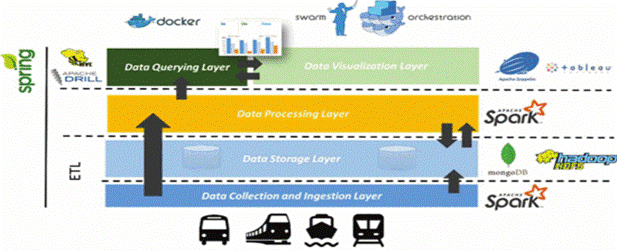
Figure 2: Big Data Architecture Overview(Antunes et al.,2019).
Despite TfL’s utilisation of technologies such as Wi-Fi connection data and SCOOT detectors, which generate an impressive 5.2 billion records daily, the integration of these datasets remains fragmented (Transport for London, 2024; Forsdick, 2019). This fragmented approach raises concerns about data silos and interoperability issues. In contrast, innovative data storage solutions employed by international counterparts enable real-time data processing and analysis, empowering transportation agencies to make informed decisions and optimise service delivery efficiently.
Data Storage and Processing
Though TFL has yet to reveal its technology for data processing, big data technologies like Hadoop, MapReduce, Spark, and GraphX should be used to process big data generated in smart cities. In general, Hadoop efficiently processes offline data, while Spark and GraphX are primarily used for processing online data, which has some processing limitations (Gohar et al., 2018). TfL’s embrace of cloud-based data warehouses, epitomised by the ‘Trackernet’ system hosted on Windows Azure, signals a move towards modernisation and scalability akin to advancements in other progressive transportation systems globally (Gohar et al., 2018).
Cloud servers are used for reliability, cost-effectiveness, security, and ease of management. However, the reliance on third-party platforms introduces a potential Achilles’ heel concerning data sovereignty and security, a concern less pronounced in transportation systems of countries like Switzerland, where stringent data protection laws and emphasis on local hosting prevail (Microsoft Azure, 2010).
Open Data and API Management
The introduction of TfL’s unified API marks a significant advancement in making transport data more accessible, reflecting similar efforts in global transportation systems (Determann, 2020). This initiative promotes innovation, enhances customer service, and supports research and collaboration. However, unlike in Germany and the Netherlands, where developer support programs are well-established, TfL’s reliance on direct API queries may pose challenges for developers less experienced with API integration, potentially limiting broader access and innovation.
Furthermore, while TfL’s regular updates are commendable, transparency must be improved in better practices in countries like Sweden and South Korea. These systems provide clear documentation on data sources and updates, building trust and accountability. TfL’s need for more transparency raises concerns about data reliability. To remain competitive, TfL must prioritise transparency and collaboration, aligning with global leaders.
Collaboration and Innovation
TfL’s commitment to collaboration and innovation, exemplified by its participation in hackathons and partnerships with the tech community, is commendable. However, the extent to which these initiatives translate into tangible solutions for transport challenges remains to be determined. While collaboration fosters creativity and shared insights, TfL must ensure that resulting innovations address the complexities of city transportation and align with broader sustainability goals.
Impact Analysis
Using big data applications, TfL has optimized resource allocation, unforeseen circumstances and delays, schedules, and routes, decreasing traffic, increasing timeliness, and improving overall operations. By identifying safety risks, keeping an eye on the condition of the infrastructure, and putting preventive measures in place, real-time data analytics assist TfL in creating a safer travelling environment for staff and customers (Weinstein, 2016). TfL could notify regular customers directly about travel-related news and changes. Because administrators can send out service updates and station adjustments instantly, customers will have a much better experience (Marr, 2015). Data provides transportation officials with the necessary information and notifies the public directly on their phones about the delay.
TfL uses it to determine the most critical transportation demands and implement innovative ideas that encourage effectiveness and user-friendliness. Travelers on the TfL network and other road users benefit from these innovative offerings to enhance their travel experiences in London. Travellers, London City, and TfL stand to gain economically each year from TfL’s open data release, which could save up to £130 million. 83% of Londoners use the TfL website with comparable data, and 42% use an app backed by TfL data. Data applications help TfL and all Capital transportation users and London’s economic goals. Travellers may make better travel plans using applications that leverage TfL’s public data to give them up-to-date information and suggestions for route modifications. This saves time and increases clarity about when the next bus or tube will come; it is projected to save between £70 million and £90 million annually.
This can also cut emissions, save time, and increase client satisfaction from rapid access to precise and trustworthy information. Users can use free web services or apps to access real-time data utilizing TfL’s open data. Fee-based SMS warnings become a cost savings of up to £2 million annually. New real-time alert services are expected to become £3 million annually. The overall gross value added by these companies from using TfL data is estimated to be between £12m and £15m GVA pa. By collaborating with outside developers, TfL may be able to save money. Open data allows TfL to expand customer reach and improve transparency at a significantly lower cost. TfL’s Big Data projects help to minimise emissions and environmental effects through optimized operations and reduced congestion (Transport for London, 2021). TfL has improved service resilience and dependability by better anticipating demand, optimizing service frequencies, and effectively handling disruptions (Transport for London, 2021).
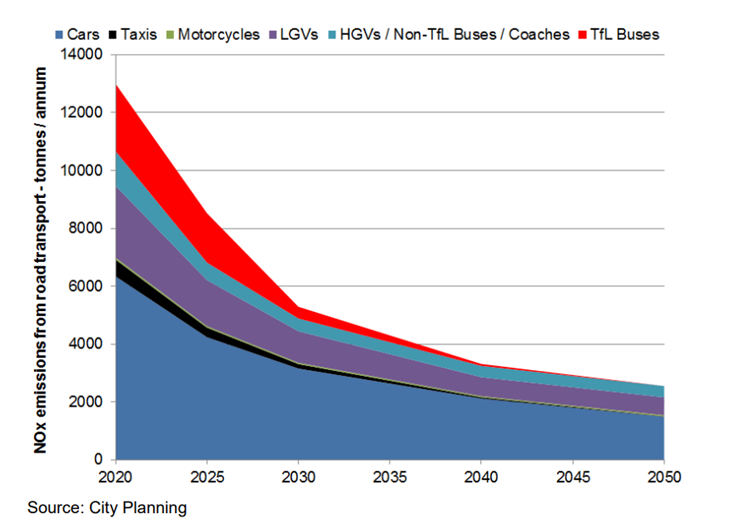
Figure 3: Baseline (without interventions proposed in MTS) NOx emissions, 2020 to 2050 (Mayor of london,2017).
Compiling data from various sources and old systems can be difficult, resulting in missing data, inconsistencies, and compatibility problems that reduce the efficacy of significant data initiatives. Passengers and stakeholders are concerned about privacy due to collecting and analyzing large volumes of personal data.
By increasing operational effectiveness, safety precautions, and customer experience, big data applications improved passenger satisfaction, fewer delays, and more seamless transportation services. It can address the changing demands of Londoners effectively. Thanks to its agility and adaptability, it gains important strategic insights into emerging issues, trends, and patterns in the transportation ecosystem (London Datastore, 2015). This helps TfL to innovate, prioritize investments, and develop data-driven plans that align with the city’s long-term transportation goals.
Solution Analysis
Artificial intelligence (AI) and machine learning (ML) technology continue to be integrated into Transport for London (TfL) operations, which leads to evident outcomes in successful operational and passenger experience. Haegeman and Wright (2023) note that introducing such technologies allows TFL to take much better control of the complex network of transportation channels, quickly handling crises such as passenger traffic bottlenecks, accidents and service delivery. As part of TfL services, AI comes in at various points in its deployment, including scheduling, loading of passengers, and safety and onboard passenger comfort points during their trip (Haponik, 2023). The diagram illustrates the functioning of the entire ITS system, including AI and ML technologies integrated across the network.
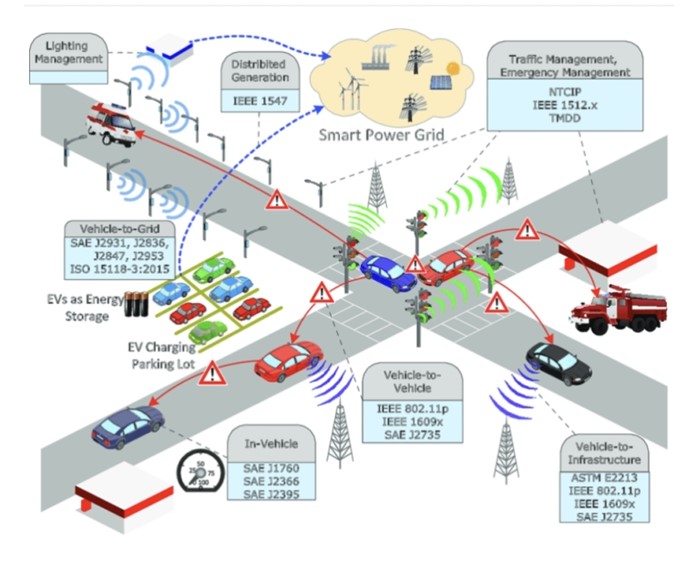
Figure 4: Intelligent transportation system (Haponik, 2023).
TfL utilises machine learning to manage traffic and predict congestion. By analysing Oyster cards, GPS, and sensor data, TfL’s models optimise travel experiences by reducing congestion and improving service efficiency (Marr,2015).
One critical application involves the “tap-out” system for Oyster card users on buses, addressing the previous limitation of tap-in-only payments. This AI-powered solution leverages bus location and tap data to calculate fares, enhancing customer satisfaction (83% reported helpful) and accurately ensuring fair pricing (Forsdick,2019; Astura,2024).
TfL’s data-driven approach allows for proactive resource planning to address future demands while prioritising safety and customer satisfaction. As AI and machine learning evolve, TfL’s integration of these tools is expected to improve London’s transport network efficiency (Stone et al., 2021). If the TfL adopted predictive analytics and data-driven approaches, future resource planning could be handled with perfection, demands could be proactively catered to, and issues relating to safety and customer satisfaction could be solved as best as possible. In the ongoing and fast development of AI and machine learning technologies, it is safe to say that TfL will integrate these tools more and more in its operations, hence improving efficiency in the transportation of London’s network and the impact on the passengers (Stone et al., 2021).
Transport for London (TfL) harnesses big data analytics to achieve real-time management of its extensive network. TfL comprehensively understands passenger movement by integrating diverse data sources like Oyster card transactions, sensor readings, CCTV footage, and Wi-Fi hotspot data (illustrated in Figure 4) (Astura, 2024). This empowers them to proactively predict traffic patterns, identify areas with surging demand, and optimise resource allocation for maximum efficiency (Shah, 2016; Zhu et al., 2018).
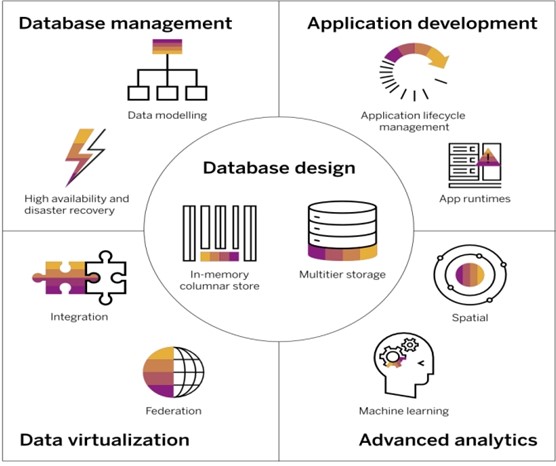
Figure 5: SAP HANA Architecture diagram (SAP, 2024).
TfL employs KPIs like learning phase reduction and customer experience metrics to assess big data solutions’ impact on operational efficiency (SAP, 2024). Their scalable big data architecture adapts to future demands, solidifying their position as a data-driven leader in transportation. By unifying data collection, management, and analysis, TfL sets a global model for public transport efficiency and customer satisfaction (Weinstein, 2016).
Data Governance & ROI
The management framework and procedures implemented by Transport for London (TFL) to guarantee the accuracy, accessibility, integrity, and security of data throughout the company are referred to as data governance. TfL is a sizable transportation organisation overseeing London’s public transportation system and works with plenty of data, from passenger data to operational data from infrastructure and vehicles.
Data governance at TfL requires the establishment of a robust data governance structure. Roles and duties must be clearly defined, data management rules and procedures must be developed, and compliance enforcement and monitoring methods must be implemented (Transport for London,2024). Regular training and awareness campaigns may also be held to guarantee adherence to data governance procedures and foster a culture driven by data.
It includes limiting access to data, encrypting it to prevent unauthorised parties from reading it, teaching staff members to identify security threats, and putting a backup plan in place if something goes wrong. The objective is to protect data from hackers and other dangers, which contributes to the security of TfL operations and passengers (Transport for London,2024).
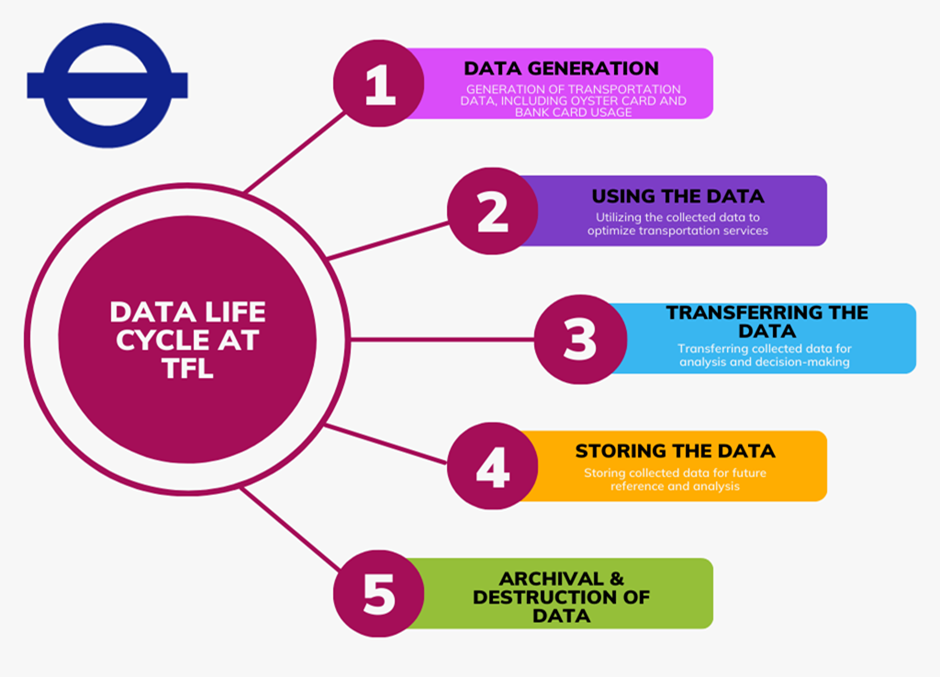
Figure 6: How data works in TFL
TfL abides by data protection laws, such as the General Data Protection Regulation 2016/679 (GDPR) and the Data Protection Act 2018. It gets permission before collecting data, anonymises it when appropriate, and instructs employees on privacy best practices. TFL has appointed a Data protection officer (DPO) who can operate independently and ensure that TFL meets the GDPR (Transport for London,2024). TFL places a high priority on data protection, which not only protects individual rights and maintains passenger trust but also helps to reduce the likelihood of privacy violations. Metal detectors should be integrated into underground stations to enhance security demands, which require thorough scrutiny regarding feasibility, effectiveness, and potential implications for passenger flow.
ROI
Transport for London has gained a lot from significant data initiatives, whether in monetary terms, operational efficiencies, or customer satisfaction. Through big data and IoT (Internet of Things), TfL can track any problems or emergencies and offer consumers a personalised update service, all while gaining profound insight into each user’s journey. (Astuta,2024)
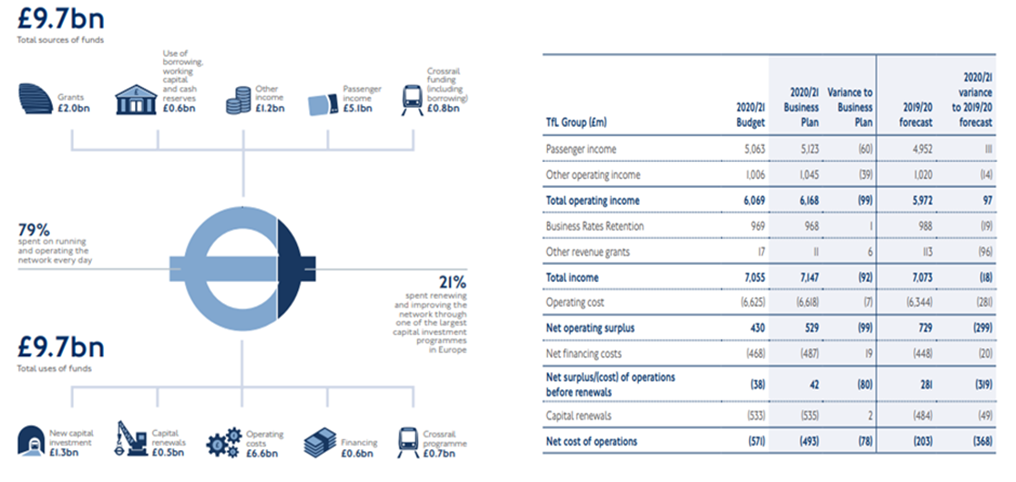
Figure 7: Cash flow at TFL (2020-21) (Astuta,2024).
TfL (Transport for London) uses extensive data analysis to enhance its services and effectively address customer needs. TfL gains insights into customer travel patterns through detailed journey analysis, allowing for service adaptations to meet specific demands. TfL can respond swiftly by tracking and identifying issues or emergencies, providing alternative transport options and personalised updates to minimise disruption. Tailored travel updates based on individual routes ensure customers receive relevant information, improving their overall experience. This personalised approach has garnered positive feedback, with 83% of passengers finding the service helpful. TfL’s commitment to leveraging open-source technology and real-time analytics demonstrates its ongoing efforts to optimise London’s public transport system and integrate insights from big data and IoT for continuous improvement. (Astuta,2024) Overall, TfL’s investment in big data analytics has resulted in substantial cost savings, economic growth, and increased operational efficiency, solidifying its position as a global leader in data-driven transportation management.
Conclusion
Transport for London (TfL) has become a frontrunner in leveraging big data for urban transportation advancements. Their diverse data sources, from Oyster cards to sensors, have significantly improved efficiency, passenger experience, and safety. Big data empowers TfL to optimise resources, predict disruptions, and personalise communication, leading to a smoother network.
Challenges remain, however. Integrating this vast data requires careful management to avoid silos and ensure consistency. Additionally, balancing enormous data benefits with passenger privacy is crucial. TfL’s commitment to data governance fosters trust. The future holds promise with TfL’s integration of Artificial Intelligence and Machine Learning. These tools can enhance traffic management, predict demand, and personalise passenger journeys. By embracing innovation and addressing data integration and privacy concerns, TfL can solidify its leadership in big data-driven transportation, paving the way for a more sustainable and user-friendly future for London’s transport network.
References:
Antunes, H. et al. (2019). Analysing Public Transport Data through the use of Big Data technologies for urban mobility, in 2019 International Young Engineers Forum (YEF-ECE), Costa da Caparica, Portugal, pp. 40-45, Available at: https://doi.org/10.1109/YEF-ECE.2019.8740816.
Astura (2024) How London Public Transport is Benefiting From Big Data & The Internet of Things. Available at: https://www.astuta.com/how-london-public-transport-is-benefiting-from-big-data-the-internet-of-things/. (Accessed: 23 March 2024)
Determann, L., 2020. Determann’s field guide to data privacy law: international corporate compliance. Edward Elgar Publishing. Forsdick, S. (2019) Big data in transport: How TfL is tracking and improving journeys with tech. Available at: https://www.ns-businesshub.com/technology/big-data-in-transport-tfl. (Accessed: 23 March 2024)
Gordon, J.B., Koutsopoulos, H.N. and Wilson, N.H.M. (2018) “Estimation of population origin–interchange–destination flows on multimodal transit networks,” Transportation research. Part C, Emerging technologies, 90, pp. 350–365. Available at: https://doi.org/10.1016/j.trc.2018.03.007.
Gohar, M., Muzammal, M. and Rahman, A.U., 2018. SMART TSS: Defining transportation system behavior using big data analytics in smart cities. Sustainable cities and society, 41, pp.114-119.
Haegeman, J. and Wright, J (2023) How AI and machine learning enhances the safety, efficiency and passenger comfort of public transport. Available at: https://www.intelligenttransport.com/transport-articles/150030/ai-machine-learning-enhances-public-transport/. (Accessed: 23 March 2024).
Haponik, A. (2024) AI, big data, and machine learning in transportation. Available at: https://addepto.com/blog/ai-big-data-and-machine-learning-in-transportation/. (Accessed: 23 March 2024)
Itoh, M. et al. (2014) “Visual fusion of mega-city big data: An application to traffic and tweets data analysis of Metro passengers,” in 2014 IEEE International Conference on Big Data (Big Data). IEEE, pp. 431–440. Available at: https://doi.org/10.1109/BigData.2014.7004260.
International Trade Administration (January 01, 2024) Singapore - Information and Telecommunications Technology (2024). Available at: https://tfl.gov.uk/corporate/privacy-and-cookies/wi-fi-data-collection#:~:text=This%20page%20explains%20how%20and. (Accessed: 14 March 2024).
London Datastore (2015). Improved Public Transport for London, Thanks to Big Data and the Internet of Things. Available from: https://data.london.gov.uk/blog/improved-public-transport-for-london-thanks-to-big-data-and-the-internet-of-things/. (Accessed: 07 March 2024).
Mayor of London,2017. Mayor’s transport strategy: supporting evidence. Challenges and Opportunities for London’s Transport Network to 2041. transport for London. available at: https://content.tfl.gov.uk/mts-challenges-and-opportunities-report.pdf
Marr, B. (2015) How Big Data And The Internet Of Things Improve Public Transport In London. Available at: https://www.forbes.com/sites/bernardmarr/2015/05/27/how-big-data-and-the-internet-of-things-improve-public-transport-in-london/?sh=3d51c1601be6. (Accessed: 23 March 2024)
Microsoft Azure (December 13, 2010) Transport for London Moves to Windows Azure. Available at: https://azure.microsoft.com/fr-fr/blog/transport-for-london-moves-to-windows-azure/ (Accessed: 14 March 2024).
New York: Dow Jones & Company Inc (2019) ‘Mitsubishi Electric Delivers Train Information Monitoring and Analysis System for Tokyo Metro’s New Marunouchi Line 2000 Series Trains’, 19 Feb [Press Release]. Available at: https://www.proquest.com/docview/2190947494?pq-origsite=primo&sourcetype=Wire%20Feeds
SAP (2024) What is SAP HANA? Available at: https://www.sap.com/products/technology-platform/hana/what-is-sap-hana.html. (Accessed: 23 March 2024).
Shah, S. (2016) TfL using SAP HANA to process big data from the Internet of hings. Available at: https://www.computing
Stone, M., Aravopoulou, E., Knapper, J., & Evans, G. (2021). Smart cities and smart transport: The role of data and insight. In The Routledge Companion to Marketing Research (pp. 401-427). Routledge.
Torre-Bastida, A.I. et al. (2018) “Big Data for transportation and mobility: recent advances, trends and challenges,” IET intelligent transport systems, 12(8), pp. 742–755. Available at: https://doi.org/10.1049/iet-its.2018.518
Transport for London (2020) Budget 2020/21 Available at: https://content.tfl.gov.uk/tfl-budget-2020-21.pdf (Accessed: 06 April 2024).
Transport for London (2021) Sustainability Report. Available at: https://content.tfl.gov.uk/tfl-sustainability-report-29-september-2021-acc.pdf (Accessed: 07 March 2024).
Transport for London (2021) Customer Service and Operational Performance Panel. Available from: https://content.tfl.gov.uk/csopp-20210224-public.pdf (Accessed: 07 March 2024).
Transport for London (2024) Every Journey Matters Privacy & Data Protection Policy, Transport for London Available at: https://tfl.gov.uk/corporate/privacy-and-cookies/privacy-and-data-protection-policy (Accessed: 21 March 2024).
Transport for London (2024) Privacy & cookies, Transport for London Available at: https://tfl.gov.uk/corporate/privacy-and-cookies/ (Accessed: 22 March 2024).
Transport for London (2024) Privacy & Data Protection policy Available at: https://tfl.gov.uk/corporate/privacy-and-cookies/privacy-and-data-protection-policy (Accessed: 02 April 2024).
Transport for London (2024) Our Open Data. Available at: https://tfl.gov.uk/info-for/open-data-users/our-open-data (Accessed: 07 March 2024).
Transport for London (2024) Wi-Fi data collection. Available at: https://tfl.gov.uk/info-for/open-data-users/our-open-data (Accessed: 07 March 2024).
Transport for London (2024) what we do. Available at: https://tfl.gov.uk/corporate/about-tfl/what-we-do?intcmp=2582#on-this-page-1 (Accessed: 07 March 2024).
Weinstein, L. (2016) How TfL uses ‘big data’ to plan transport services. Available at: https://www.intelligenttransport.com/transport-articles/19635/tfl-big-data-transport-services/. (Accessed on 23 March 2024)
Zhu, L., Yu, F. R., Wang, Y., Ning, B., & Tang, T. (2018). Big data analytics in intelligent transportation systems: A survey. IEEE Transactions on Intelligent Transportation Systems, 20(1), 383-398.
Disclaimer
This report was originally submitted as part of the coursework requirements for the Master of Science in Data Science and Analytics at the University of Westminster. The content reflects the author's academic research and findings at the time of submission.
While efforts have been made to ensure accuracy, the report may not be free from errors or may not reflect the most current developments in the field. The views and conclusions expressed are those of the author and do not necessarily represent those of the University of Westminster or any affiliated institution.
This document is provided for informational and educational purposes only. It should not be used as a substitute for professional advice or as an official representation of industry standards. The author and the University of Westminster disclaim any liability for any direct or indirect consequences resulting from the use of this material.
For any inquiries or permissions regarding the reproduction of this work, please contact the author.